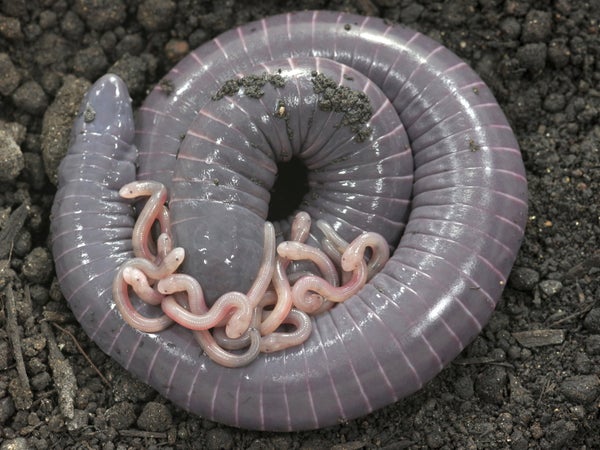The First Amphibian Known to Beg Its Mother for Milk Is More Bizarre than You Might Imagine
Surprisingly, the young of limbless amphibians called ringed caecilians stimulate their mother by touch and sound to release a milklike substance
A ringed caecilian (Siphonops annulatus) mother with newborn babies.
Caecilians are amphibians—like frogs, toads, salamanders and newts—but they look more like worms. They have no limbs and possess very rudimentary eyes, and many spend their entire life underground. This makes them very hard to study, says herpetologist Carlos Jared of the Butantan Institute in Brazil, who has spent the past 50 years getting to know them. “They are difficult to find, difficult to keep alive in the lab, difficult to breed and difficult to observe without disturbing them,” he says.
This means caecilians are still full of surprises, as Jared and his colleagues show in a new study published on Thursday in Science. Somewhat like mammals, the paper explains, females of the ringed caecilian (Siphonops annulatus) produce a milklike substance to feed their young. And remarkably the hungry hatchlings seem to actually beg their mother to release more milk—a type of behavior that has never been observed in amphibians before.
The road to this latest discovery began when a BBC team shooting footage for the series Life in Cold Blood used an endoscopic camera to film a ringed caecilian female and her offspring without disturbing them. At one point the hatchlings suddenly went into a frenzy of activity and were observed tearing off bits of their mother’s whitish outer skin layer (which only breeding females develop). This skin turned out to be full of nutritious proteins and fats, says study co-author Marta Antoniazzi of the Butantan Institute. “We were so intrigued by this that we didn’t pay much attention to the other behaviors we saw,” she says. Yet over time the researchers realized that a weekly mouthful of skin would not…
Read the full article here







